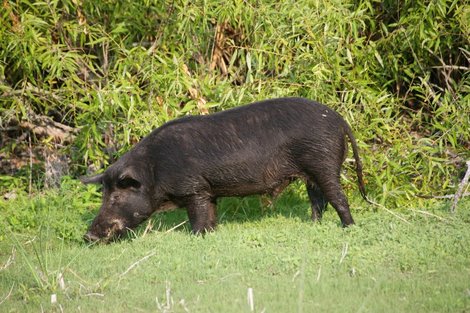
I was locking a pipe-rail gate behind R.L. Loving’s pickup truck, when the woman walked through her patio door, into her backyard, shielded her eyes with a hand and stared intently across the bayou at us. “This could go either way,” R.L. said.
In the back of his truck squatted a large cage made of heavy-gauge wire. Inside the cage were three live feral hogs — a big sow and a couple of shoats. We were on the edge of a large tract of as-yet-undeveloped property barely outside Houston’s city limits and hard against a patch of suburbia filled with half-million-dollar homes.
R.L., an accountant and financial adviser by profession but an outdoorsperson at heart, had permission — the blessing, really — of the folks who control the tract to live-trap and remove feral hogs there. He is good at it.
We were on the way out of the tract with the morning’s catch when the lady “caught” us with our load.
Some suburban dwellers get upset — downright indignant or abusive or even call the police — when they see R.L. with the feral hogs he traps. They seem to see him as some kind of poacher or plunderer of wildlife. And they can get quite vocal with their opinions that he should just leave the poor little wild pigs alone.
We braced for the possibility that the woman so keenly eyeing us might unleash a torrent of venom.
She did. Just not at us.
‘Kill them all!’
She stood there for a few seconds, arms crossed, and I could see her look at us, then look at the ground just outside her metal fencing.
That ground looked like it had been plowed by some drunken tractor operator, gouged and ripped and veined with muddy, calf-deep, serpentine ruts.
The unfenced yards of a couple of her neighbors looked much, much worse. They were mudholes instead of nice, green sheets of San Augustine. And the feral hogs in the back of R.L.’s truck were almost certainly among the porcine vandal horde responsible for the property damage.
The woman looked at the hogs in the back of the truck, glanced at the trashed ground, then back at us.
She unfurled her arms, lifted both hands in a “thumbs-up” signal and yelled across the bayou, “Kill them all!”
Most people who have seen, been a victim of, or understand the impact of feral hogs on people, land, wildlife and property share the woman’s opinion of the wild pigs. That’s getting to be a lot of people.
Feral hogs, once restricted to pockets of riverbottom habitat in East and South Texas, now live in all but a half-dozen or so of Texas’ 254 counties. Their Texas population, highest in the nation, has been estimated as high as 2 million, or about half as many hogs as there are white-tailed deer in the state.
As Texas’ feral hog population has exploded over the past 20 years, so has the damage the invasive species wreck on the environment, agriculture, property and other wildlife.
Texas officials estimate feral hogs are annually inflicting $52 million or more in damage to the state’s agriculture industry. Texans are spending more than $7 million a year repairing that damage or trying (unsuccessfully) to control feral hog populations.
Disease transmission potential from the atavistic swine is a major concern of the state’s huge and economically crucial livestock industry.
And the damage feral hogs do to wildlife is just as considerable, if not as easily quantifiable. That damage includes competing with native species for resources and space, predation on ground-dwelling wildlife (mostly reptiles and amphibians, but also ground-nesting birds) and impacts on the type, quality and quantity of vegetation and other native forage.
Texas rural landowners and folks who hunt, fish, hike, bird or otherwise enjoy the state’s natural resources have for years seen the damage feral hogs are doing. And most were long ago convinced that the wild swine are a plague that needs serious attention. But what can traping do? It’s time consuming and takes lots of man-hours!
But all this has escaped most of the state’s urban and suburban residents, people who have little if any connection to the land, its wildlife and other natural resources. That’s changing. Feral hogs are moving into the ‘burbs. Or the suburbs are moving into hog country.
Homeowners at the edges of almost every city in Texas are seeing the impacts of the feral hog infestation. They see it in their rooted-and-destroyed lawns. They see it when their minivan collides with a 150-pound pig. And they see it when that nice little local park gets turned into a muddy, rutted mess.
Feral hogs are negatively impacting their bank accounts and their peace of mind. They want them gone. Join the crowd.
——————-
Reprinted from Houston Chronicle by Shannon Thompkins